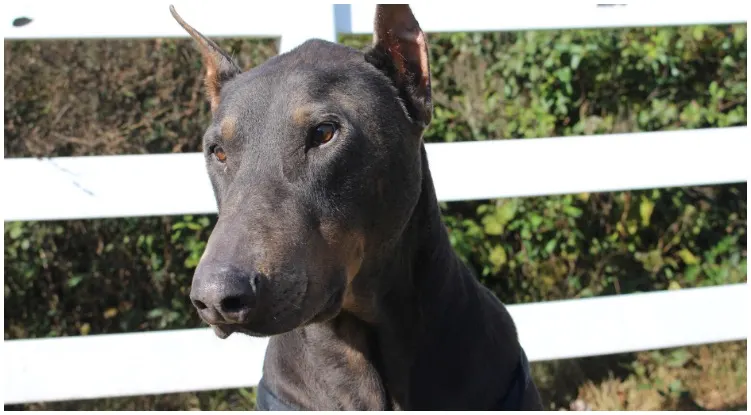You are most likely already familiar with Dobermans. These dogs are graceful but large and muscular. They were originally created by a tax collector in Germany who needed an intimidating dog to help him get the money. But, Dobermans soon became popular all over the world, by people of all profiles. While most of them are black and brown, there is also the blue Doberman. But their coat is much more than a color variation.
There is a lot to know about this beautiful dog, but sadly we have some bad news about them too. If you want to learn more bout the blue Doberman, then keep on reading.
While you’re here, read more about the Doberman breed:
- Doberman Uncropped Ears: Better Or Worse?
- Red Doberman: The Good And The Bad
- American VS European Doberman
- Black Doberman: The mystic beauty
- Doberman Colors: All their beautiful shades
- White Doberman: Complete Guide
- European Doberman: Complete Breed Info
What is a Blue Doberman?
When we say Doberman you probably think of a black and rust-colored dog. But the coat of the Doberman can be many different colors. The American Kennel Club lists four coat colors for this breed: black and rust, blue and rust, fawn (isabella) and rust, and red and rust. Dobermans can also be white, but the AKC doesn’t accept them.
First of all, don’t think that these dogs are blue in the real sense of the word. They aren’t by any means walking Smurfs. Their coat is more of a diluted black color, which gives them that blueish undertone.
While their blue color is incredibly beautiful it’s actually the result of a genetic abnormality. The color dilution gene inhibits the full pigmentation, causing the coat to appear diluted. According to the Doberman Pinscher Club of America, dilution is a recessive gene. Every Doberman has a pair of color genes (black B or red b) and a pair of dilution factor genes (dd). The blue coat color is possible when a black Doberman (BB or Bb) has both dilution genes present (dd). It was worth paying attention in biology class, huh?
Their possible fawn color is actually also caused by a similar gene. The only difference is that this gene dilutes the color red. Both of these used to be undesirable and a sign of a sick dog a few years back. But, now things have changed. These coat colors are now accepted by people and embraced. But, there are a few conditions that the blue or fawn Doberman are prone to due to this genetic mutation.
What is blue balding syndrome?
The blue Doberman syndrome is a group of symptoms of Dobermans with this recessive gene. The most common symptom is alopecia. That’s why this condition is also known as a blue balding syndrome or color dilution alopecia.
This is a hereditary condition that doesn’t only show up in Dobermans. You can see it in any dog breed with diluted coats. Alopecia basically means that your dog’s coat will fall out in certain spots. These poor dogs will usually get hair loss in the areas where their coat color is diluted. The tan areas will usually stay the same. The hair loss may start on the top line and then spread to the back.
Your dog may not show signs right away. Puppies won’t show any signs of it until they already left their breeder’s home. It can take from six months to three years of age for this condition to appear. This is why it’s important to find a reputable breeder.
Blue and fawn Dobermans usually get this condition. The frequency can be as high as 93% in blues and 75% in fawns.
The coat of affected dogs may also start to turn dry and scaly. You could even notice some broken hairs. And very soon after that, the bald spots will start appearing as well.
What to do if you notice any symptoms?
If you notice your blue (or fawn) Doberman start developing a skin condition, contact your vet. Sadly, it’s not possible to fully treat it, there are ways to deal with it though. But, one thing your vet will want to do is rule out other possible reasons your dog is turning bald.
Your vet will want to rule out low thyroid levels or other hormone-related conditions. The vet may take blood samples or do a skin biopsy. But, if you want a definitive diagnosis then only a microscopic evaluation of the hair and hair shafts can help. There is a chance that you will have to also visit a dog dermatologist.
There is no definitive treatment for blue Doberman syndrome. If your dog has other skin infections, antibiotics will help. Other possible treatments are supplements to improve your dog’s skin like fatty acids and Vitamin A. Your vet will give you the best advicce what to get for your dog.
But, don’t get discouraged if your dog has these problems. Even with hair loss they can still live a long and healthy life. The blue Doberman syndrome is more of a cosmetic issue than a health one.

